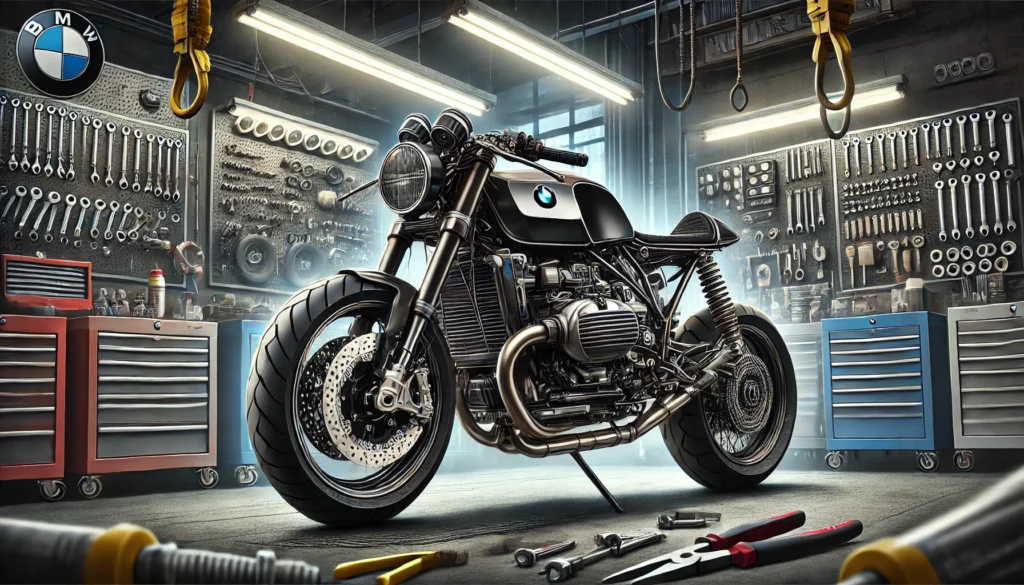If you own a BMW K100 and are looking for a way to improve its handling and suspension, swapping in ZX10 forks on a K100 could be the perfect upgrade. The K100, while a fantastic bike, features suspension technology that’s over 30 years old. Modernizing the front end with ZX10 forks on a K100 from the Kawasaki ZX-10 sportbike will not only improve performance but also give your bike a more aggressive, sporty feel. In this guide, we’ll walk you through why you should consider this upgrade, what to expect during the swap, and how to do it.
Why Consider the ZX10 Fork Swap?
The BMW K100, while revered for its smooth ride and classic design, has suspension that can feel outdated by today’s standards. The stock forks are basic, offering minimal adjustability and less precision in handling compared to modern sportbike suspension systems.
By swapping in ZX10 forks, you’ll be upgrading to a far superior suspension system. The Kawasaki ZX-10 is a high-performance sportbike known for its precise handling and adjustable forks. This upgrade will allow you to experience better damping, more responsive steering, and an overall smoother ride. If you’re looking to enhance your K100’s handling and modernize its front end, ZX10 forks are an excellent choice.
Key Considerations Before You Start
Before diving into the swap, there are a few things to consider to ensure the project goes smoothly.
Fork Length and Geometry The length of the ZX10 forks might be longer or shorter than the K100’s original forks, which will affect the bike’s geometry and handling. If the ZX10 forks are longer, your bike may become too tall, making it feel less stable or harder to control. If they are shorter, your bike may sit lower, potentially affecting ground clearance. You’ll likely need to adjust the rear suspension or lower the front end to balance the geometry.
Steering Stem Compatibility The steering stem is an important part of the fork swap process. The K100 and ZX10 may have different stem diameters, which means the steering stem from the K100 may not fit directly into the ZX10’s triple clamps. To resolve this, you might need to modify the K100’s steering stem or use the ZX10 stem, ensuring proper alignment and fitment.
Axle and Wheel Compatibility Another important consideration is the axle size. The ZX10’s forks typically use a larger diameter axle than the K100. This means the K100’s original wheel might not fit the ZX10 forks without modification. You’ll either need to swap to the ZX10’s wheel or use spacers and adaptors to make everything work.
Brake Mounts The brake calipers on the ZX10 forks may have a different mounting pattern than the K100’s, meaning the stock K100 brake components may not fit. You may need to use ZX10 calipers, rotors, or custom adapters to ensure everything is aligned correctly for safe braking.
Step-by-Step Guide to the Fork Swap
Now that you know the key considerations, here’s a simplified step-by-step guide on how to swap ZX10 forks onto your K100.
Step 1: Preparing Your K100
Before anything, you need to remove the K100’s front-end components. This includes removing the front wheel, brake calipers, stock forks, and triple clamps. Make sure you carefully document or label the components so you can put everything back in its original place if needed.
Step 2: Choosing the Right ZX10 Forks
The first thing you’ll need is a set of ZX10 forks. It’s essential to choose forks from a compatible ZX10 model. While the forks from any ZX10 sportbike (like ZX-10R) may work, be mindful of the specific year and any changes in fork design or mounting styles between models. You may also want to opt for forks with adjustability features, such as preload and damping adjustments, to further fine-tune the bike’s handling.
Step 3: Modifying or Swapping the Steering Stem
Now comes the tricky part: making the steering stem fit. You’ll need to either press the K100’s steering stem into the ZX10’s triple clamp or swap the entire steering stem assembly. This may require some custom machining, so it’s a good idea to consult with a professional or look for an aftermarket stem kit designed for this specific swap.
Step 4: Wheel and Axle Adjustments
At this point, you will likely need to swap the K100’s front wheel with the ZX10’s wheel, as the axle diameters will differ. If you want to keep your K100 wheel, you can use axle spacers or adapters to make it fit the ZX10 forks. Ensure that the axle is correctly aligned with the wheel and that the brake rotor clearance is correct.
Step 5: Installing and Reassembling
Once everything is aligned and modified, it’s time to reassemble. Install the modified or swapped steering stem into the triple clamp, bolt the forks into place, and reattach the front wheel. Next, fit the brake calipers and rotor, ensuring everything is properly aligned for safe braking. Tighten all fasteners to the manufacturer’s recommended torque specifications and perform a final inspection.
Potential Challenges and Solutions
While swapping ZX10 forks into your K100 can be rewarding, there are a few challenges you might encounter:
Handling Geometry Changes If the ZX10 forks are a different length, you may notice the bike handling differently. If the front is taller, it might make the bike feel less stable, while a lower front end might decrease ground clearance. To fix this, you can adjust the rear suspension to compensate for the height change or even lower the front end by adjusting the fork tubes in the triple clamps.
Parts Compatibility Since the K100 and ZX10 are different bikes, you might run into issues with brake calipers, rotors, or axle sizes. Be prepared to either swap parts from the ZX10 or use custom adapters to make everything work. Ensure all parts fit securely before riding.
Time and Cost This isn’t a simple bolt-on upgrade—it may require custom work, fabrication, and parts that could be expensive or time-consuming to source. Make sure you’re ready to invest the necessary time and money into the project.
Last Words on zx10 forks on a k100
Swapping ZX10 forks on a K100 is a great way to upgrade the bike’s handling and suspension. With modern technology from the ZX10, you’ll experience smoother, more responsive performance that dramatically improves the bike’s ride quality and control. While the swap does come with some challenges—like fork length adjustments, steering stem modifications, and brake compatibility—it’s an excellent project for motorcycle enthusiasts looking to breathe new life into their K100.
If you’re up for the challenge, this ZX10 forks on a K100 swap will make your BMW K100 handle like a more modern sportbike, giving you a thrilling, smoother ride. Happy riding!
Frequently Asked Questions (FAQs)
What are the benefits of swapping ZX10 forks on a K100?
Swapping ZX10 forks on a K100 improves handling, suspension performance, and overall ride quality, giving your bike a more modern and aggressive feel.
Are ZX10 forks compatible with the K100 without modifications?
No, ZX10 forks on a K100 require modifications to the steering stem, axle, and brake mounts to fit properly.
Can I keep my original K100 wheel with ZX10 forks?
The K100’s wheel may not fit directly with the ZX10 forks due to different axle sizes. You’ll likely need to use the ZX10 wheel or adapt the K100 wheel with spacers.
How will the ZX10 fork swap affect my bike’s handling?
The swap will significantly improve handling, offering better damping and responsiveness. However, you may need to adjust rear suspension or fork height for optimal geometry.
Is swapping ZX10 forks on a K100 a difficult project?
It’s a moderately challenging project that requires custom work, including steering stem modifications and potential brake and axle adjustments. Basic mechanical knowledge is recommended.
Article Recommendations:
How El Aceite Lucas Ayuda Para El Blowby in Your Engine
How to Fujitsu MAP3367NP Hook Up to Modern Mac
Zilvinas Gudeliunas Kai Newton: Digital Innovator









